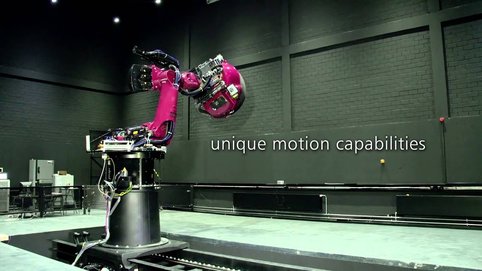
The CyberMotion Simulator
The use of this robot as a motion simulator offered many advantages over standard Stewart platforms with a hexapod motion system, for example higher dexterity, a larger motion envelope, sustained centrifugal accelerations, and the possibility to place subjects in extreme orientations (e.g. upside-down).
The CyberMotion Simulator (CMS) offered a unique facility that can accommodate many different perception, cognition and action experiments. The experimental studies that were conducted on the CMS included fundamental studies on human self-motion perception, motion cueing, spatial orientation, pilot modeling, tele-operation and EEG studies.
The CMS consisted of an industrial robot arm with six independent axes, extended with an L-shaped cabin axis. The seventh axis allowed for varying the orientation of the cabin with respect to the robot arm by changing the location of the cabin's attachment point from behind the seat to under the seat, or any intermediate position. The CMS had been further extended with a linear axis of ten meters. The resulting eight degrees-of-freedom (DOF) provided an exceptionally large workspace. Several extreme motions and positions could be achieved, such as large lateral/longitudinal motions, sustained centrifugal motions, infinite head-centered rotation, and up-side-down motions. Such motions and positions could not be achieved in conventional simulator architectures, which made the CMS a unique test bed for studies into motion perception and spatial orientation. To ensure the synchronous motion of the robot axes and the external axes (cabin and linear axis) custom software was developed. This software combined/distributed the signals coming from/going to the respective axes while making sure all timing requirements are met. Furthermore it also monitored the safety status of the system ensuring very high safety standards.
The cabin (including the cabin axis) was custom built, and allowed for mounting a range of different input/control devices:
- Button boxes (custom built)
- Pointing devices (custom built)
- Car steering wheel and pedals (Sensodrive GmbH)
- Helicopter collective (Wittenstein aerospace & simulation GmbH)
- Helicopter cyclic (Wittenstein aerospace & simulation GmbH)
- Side-stick (Wittenstein aerospace & simulation GmbH)
The cabin was equipped with a stereo projection system (eyevis GmbH) with a field-of-view (FOV) of 140ºH x 70ºV and a resolution of 1920 x 1200 on each projector. High fidelity 3D visualization could be achieved with projection filters and glasses (Infitec).
